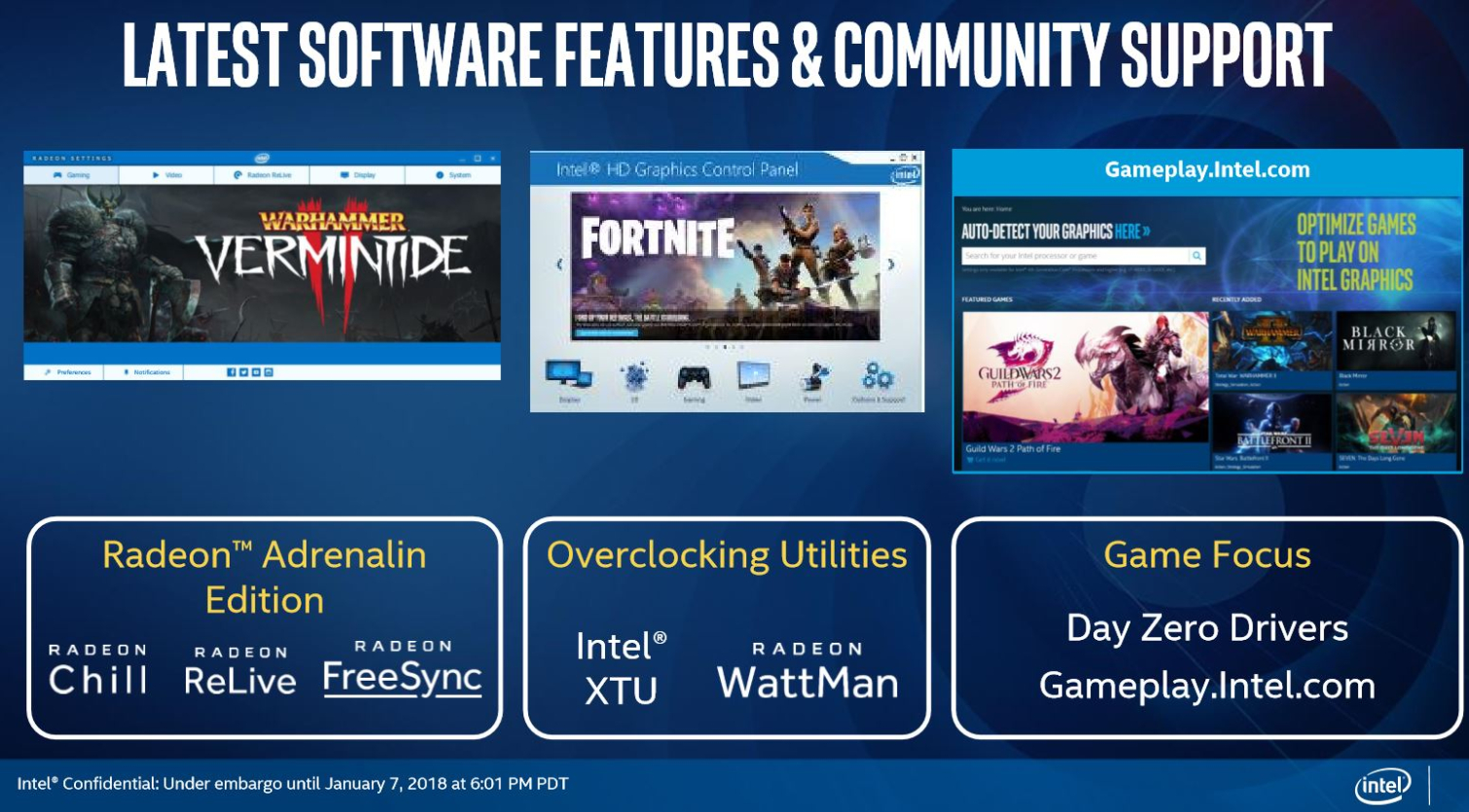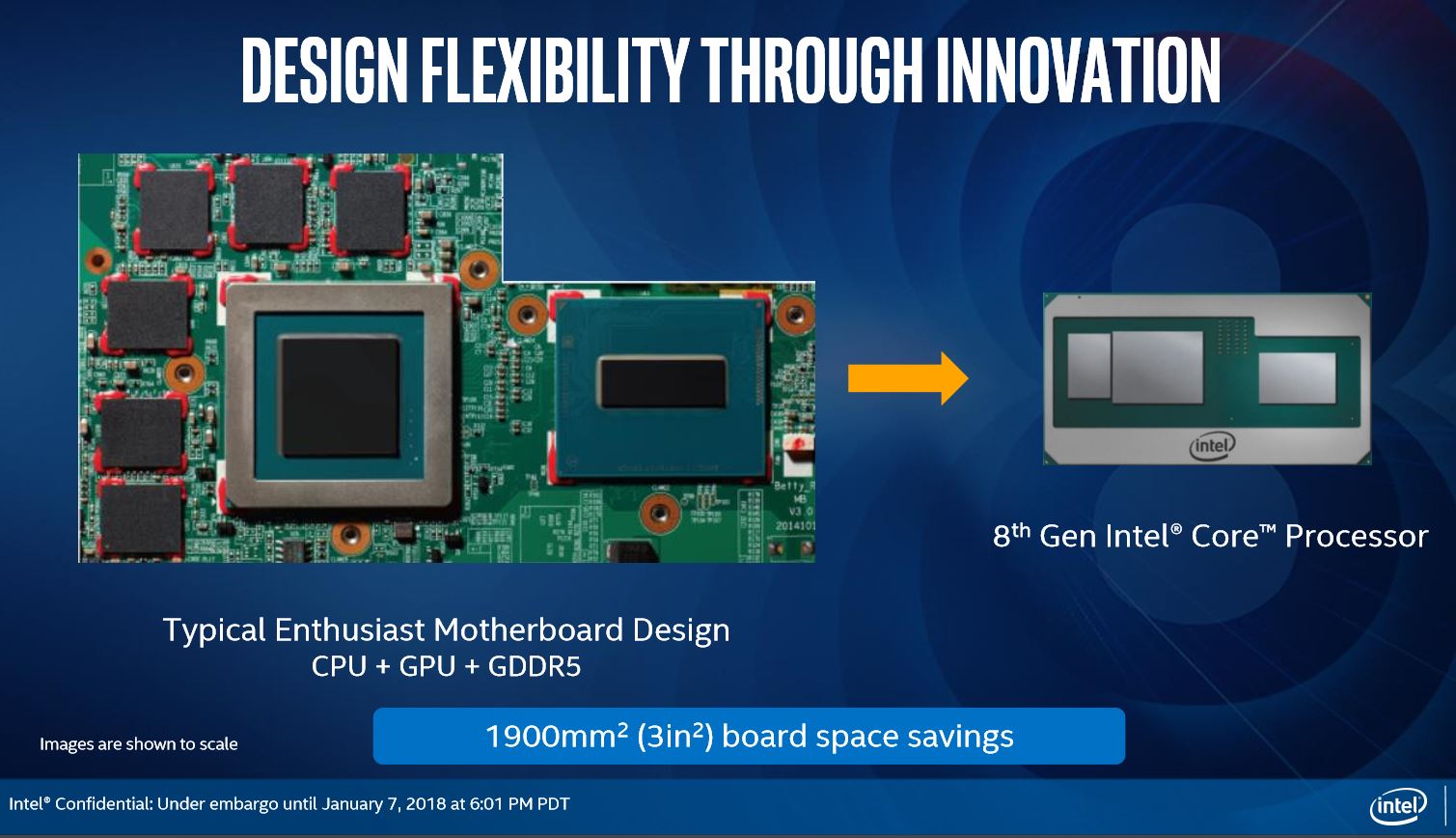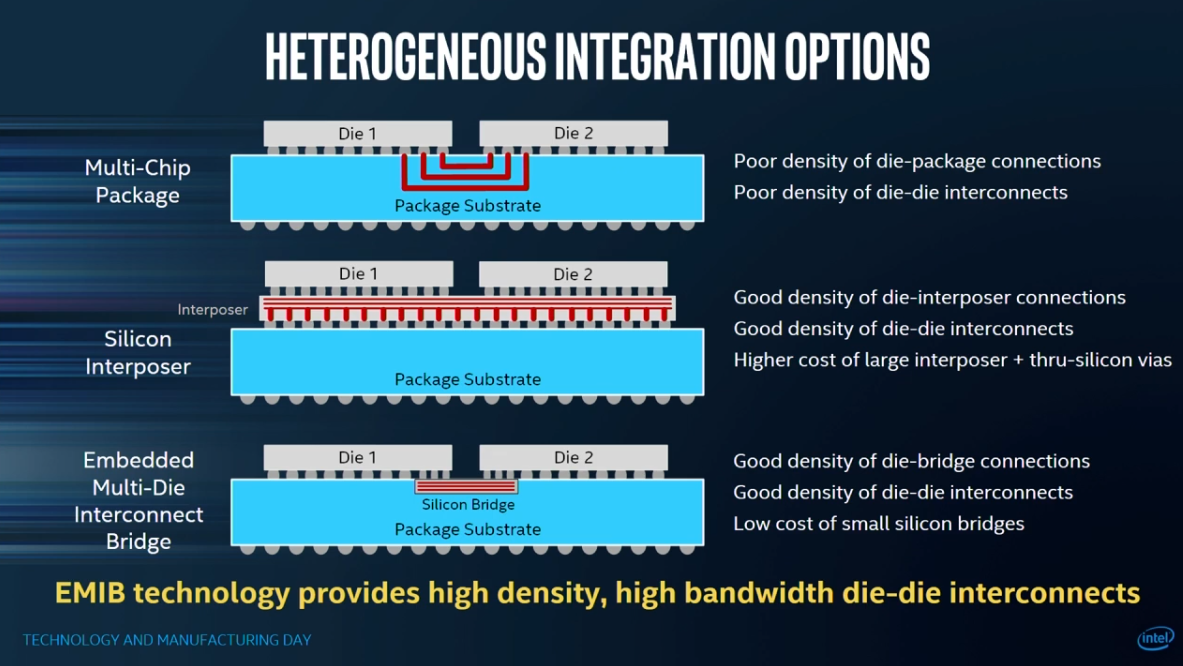Intel's Radeon Vega-Powered 8th-Gen Processors, Detailed
LAS VEGAS, NV -- Intel officially announced at CES 2018 that its new 8th-Gen processors with AMD's Radeon RX Vega graphics are coming to market. The processors will also feature an overclockable SKU that allows tuning the CPU, GPU, and HBM2 memory. The new processors will even make their way into the new 100W Hades Canyon NUCs.
We first learned of Intel's plans in November 2017 when the company disclosed that it was developing a new line of processors sporting H-Series processors and custom AMD Radeon GPUs. Surprisingly, that means Intel is now an AMD customer. Early this week, Intel accidentally posted one of the new processors to its India site, which tipped us off that the new overclockable processors would come with the Vega architecture, as we suspected.
Now, Intel is taking the wraps off the new 8th-gen Intel Core Processors with Radeon RX Vega M Graphics (a.k.a. "Kaby Lake G"). Intel's goal is to use these new processors to cram more performance into slimmer devices, particularly for enthusiast gaming, digital content creation, and VR experiences.
Intel claims the processors are on par with Nvidia's discrete graphics cards for gaming laptops, yet Intel's new slim design can fit into devices as thin as 17mm. That's a big improvement over the 26mm average thickness of an Intel-powered notebook with discrete Nvidia graphics. According to Intel, now it can beat an Nvidia 1060 Max-Q in gaming with a thin-and-light device that has a long battery life, too.
Intel claims to have accomplished these feats with a new design that packages a CPU (right), Vega Graphics (middle) and HBM2 memory (left) onto one impressively thin multi-chip package. We'll dive into some of the innovative new technologies behind these thin processors shortly, but first, let's look at the speeds and feeds.
8th-Gen Intel Core Processors with Radeon RX Vega M Graphics
Intel splits the family into four Core i7s and one Core i5 model. The 14nm+ processors come paired with either the Radeon RX Vega M GH or Radeon RX Veg M GL graphics. The GH cleverly stands for "Graphics High," while the GL means (you guessed it) "Graphics Low." The GH models have a 100W TDP, whereas the GL models have a 65W rating. These units each have unique specifications, which we'll come back to shortly.
| Intel Processors | Core i7-8809G | Core i7-8709G | Core i7-8706G | Core i7-8705G | Core i5-8350G |
|---|---|---|---|---|---|
| TDP / SDP | 100W | 100W | 65W | 65W | 65W |
| Core/Threads | 4 / 8 | 4 / 8 | 4 / 8 | 4 / 8 | 4 / 8 |
| Base Frequency (GHz) | 3.1 | 3.1 | 3.1 | 3.1 | 2.8 |
| Boost Frequency (GHz) | 4.2 | 4.1 | 4.1 | 4.1 | 3.8 |
| L3 Cache (MB) | 8 | 8 | 8 | 8 | 6 |
| Memory Channels | Dual Channel | Dual Channel | Dual Channel | Dual Channel | Dual Channel |
| Memory Speed | DDR4-2400 | DDR4-2400 | DDR4-2400 | DDR4-2400 | DDR4-2400 |
| Unlocked CPU, GPU, HBM2 | Yes | No | No | No | No |
| Discrete Graphics | Radeon RX Vega M GH | Radeon RX Vega M GH | Radeon RX Vega M GL | Radeon RX Vega M GL | Radeon RX Vega M GL |
| Intel HD Graphics | 630 | 630 | 630 | 630 | 630 |
| Graphics Boost Frequency (MHz) | up to 1100 | up to 1100 | up to 1100 | up to 1100 | up to 1100 |
| Intel vPro Technology | No | No | Yes | No | No |
The 8th-Gen H-Series features Kaby Lake-Refresh KL-R processors. This will undoubtedly confuse Intel's customers, who now associate 8th-gen processors with the Coffee Lake architecture. Remember, though, that Intel's 8th-gen is the first generation to feature multiple architectures.
Get Tom's Hardware's best news and in-depth reviews, straight to your inbox.
The flagship Core i7-8809G features four hyper-threaded cores accompanied by a total of 8MB of L3 cache. The processor boosts up to 4.2 GHz and has a base frequency of 3.1 GHz. The processors support the Kaby-standard dual-channel DDR4-2400 (no ECC). Intel provided only one model with an unlocked multiplier, and unsurprisingly, it's the most expensive. The unlocked multiplier allows you to tune the CPU, GPU, HBM2, and system memory, which Intel hopes will attract the enthusiast crowd.
Intel also has a less-expensive Core i5 model with four Hyper-Threaded cores that operate at a 2.8 GHz base frequency and boost up to 3.8 GHz. Intel pared back the L3 cache to 6MB on the Core i5 model, but there is a surprisingly small difference in clock speed compared to the other models. All the new H-Series processors are soldered to the motherboard via a BGA connection, so these won't drop into a standard motherboard.
The Core i7-8706G is the lone processor to support vPro, so Intel will also aim this model at the commercial market.
Radeon RX Vega M Graphics
You'll notice that the processors feature both Intel's integrated HD Graphics 630 and AMD's discrete Vega graphics. Intel activates the integrated HD Graphics 630 to help reduce power consumption when the processor doesn't need to bring the full heft of the discrete Vega graphics to bear. That allows the processor to power gate (turn off) the Vega graphics engine and its connected HBM2 memory during light graphical workloads, which saves power.
Intel's HD Graphics 630 has plenty of power for many mundane tasks, such as watching movies or using basic desktop applications. The integrated Intel graphics can power up to three displays, but the Radeon Graphics engine supports up to six 4K displays simultaneously. Unfortunately, the discrete Vega graphics will stay powered constantly during that somewhat extreme use case. The processors also support Radeon FreeSync Technology. Intel's HD Graphics 630 doesn't support FreeSync, so it's likely that using the feature would also prevent shutting down the Vega graphics engine, making it a power-sapping feature.
| Intel Processors | Core i7-8809G, i7-8709G | Core i7-8706G, Core i7-87505G, Core i5-8305G |
|---|---|---|
| Graphics Version | Radeon RX Vega M GH Graphics | Radeon RX Vega M GL Graphics |
| Architecture | Vega M | Vega M |
| Compute Units | 24 | 20 |
| Stream Processors | 1536 | 1280 |
| Base GPU Clock (MHz) | 1063 | 931 |
| Boost GPU Clock (MHz) | 1190 | 1011 |
| Memory Bandwidth (GB/s) | 204.8 | 179.2 |
| Peak SP Performance (TFLOPS) | up to 3.7 | up to 2.6 |
| Texture Units | 96 | 80 |
| ROPs | 64 pix/clk | 32 pix/clk |
| Memory Interface Width | 1024-bit | 1024-bit |
| High Bandwidth Cache | 4GB HBM2 | 4GB HBM2 |
The Radeon RX Vega M GH Graphics comes with 24 compute units and 1,536 stream processors. The GPU features a base clock of 1,063 MHz that stretches up to 1,190 MHz. The GPU has 4GB of HBM2 memory (4-hi stack) directly attached via Intel's EMIB technology. The HBM2 runs at 800 MHz and provides up to 204.8 GB/s of bandwidth, which is half of RX Vega 56's 410 GB/s with two 4-hi stacks (8GB) of HBM2. Of course, performance isn't comparable, because the GH provides up to 3.7 TFLOPS of peak SP performance, whereas Vega 56 reaches 10.5 TFLOPS.
The Vega M GL Graphics come with 20 compute units, and naturally features lower base/boost frequencies of 931 and 1011 MHz, respectively. The HBM2 operates at 700 MHz and provides 179.2 GB/s of bandwidth. The discrete graphics unit provides up to 2.6 TFLOPS.
Radeon RX Vega M GH Performance
Intel provided a few benchmark comparisons of its Core i7-8809G with Radeon RX Vega M GH Graphics in a few common applications. As with all vendor-supplied benchmarks, you should take them with a grain of salt.
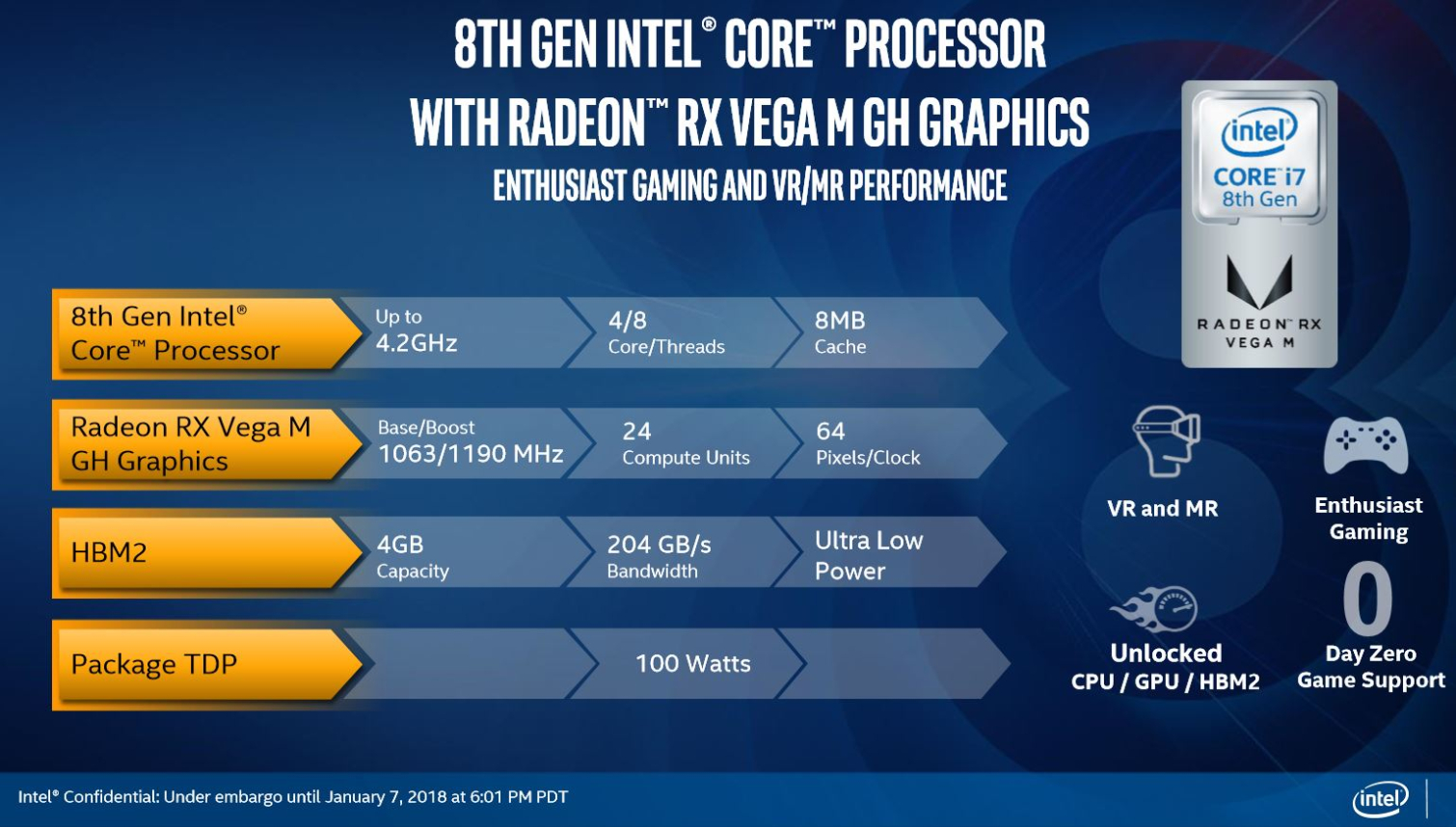


Intel set the bar high and compared its flagship to a system with a Core i7-7700HQ and Nvidia GTX 1060 Max-Q Graphics. The test notes (which are at the end of the article in a click-to-expand format) show that Intel tested the processors on a reference platform. The Vega-powered Intel system handily beat the Nvidia system during the 3DMark 11 graphics test, and it also leads through a series of three games. It's noteworthy that these three titles tend to be CPU-bound if you test them with beefier graphics cards.
Interestingly, Intel tested Total War: Warhammer with DX12 on the 8th-Gen platform and DX11 on the Nvidia systems for all tests. This is due to a lack of DX12 Async Compute support. Overall, Intel claims the 8th-Gen system is 1.13x faster throughout the range of tests.
Most users update their laptop every three years, so Intel also provided test results against a three year-old-system with a Core i7-4720HQ and Nvidia GTX 960M Graphics. As expected, the new system wins by large margins in all of the tests. The 8th-Gen processor does surpass 60 FPS in all but one title, even though Intel tested them all at high settings.
Radeon RX Vega M GL Performance
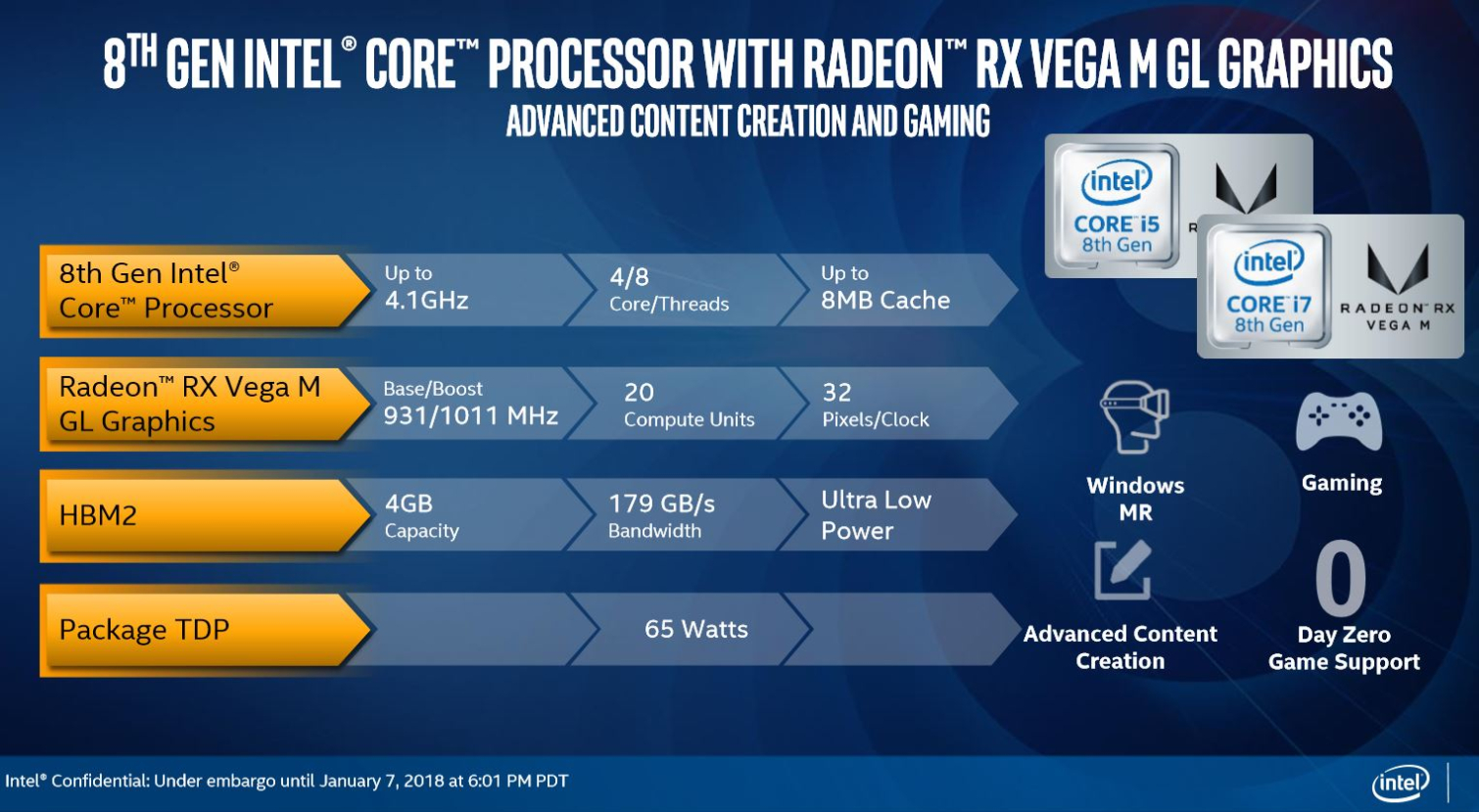


Intel tested the lower-spec'd Core i7-8705G processor with Radeon RX Vega M GL graphics against a Core i7-8550U with Nvidia GTX 1050 graphics. Again, the company recorded higher performance across the board, with notably large wins in Hitman and Deus EX: Mankind Divided.
The company also brought out a Core i7-4720H with Nvidia GTX 950M Graphics to represent a three-year-old system, but this time Intel didn't include as many gaming benchmarks. For instance, Intel included four game tests for the comparison on the high end, but only one game for the low-end model. The company included more synthetic benchmarks, such as 3DMark Time Spy and 3DMark 11, but also threw in Handbrake and Adobe Premiere Pro tests. As expected, Intel's new processors show a lead over the competing system.
As always, we advise you to wait for third-party benchmarks before making a purchasing decision.
Overclocking And Support
Intel will provide all support for the processors, including drivers for the discrete Vega graphics. AMD actually creates the drivers and delivers them to Intel for certification, though. Intel will also deliver day-zero drivers for new games. The new processors also support Intel's XTU and Radeon's WattMan for overclocking. Of course, you can also tune the system from the BIOS.
Shrinking The Package
Intel gave us the details of its new EMIB (Embedded Multi-Die Interconnect Bridge) earlier this year at the Hot Chips conference. Our "Hot Chips 2017: Intel Deep Dives Into EMIB" article covers all of the details of the new technology. In a nutshell, the EMIB interconnect ties multiple discrete chips together into a single heterogeneous package. The connection consists of a small silicon bridge, or several of them, embedded into the package substrate. This provides several advantages over other types of packaging technologies.
This technique rids the design of the multiple-interposer approach you can see in the graphic above. On the left, you can see what a typical motherboard design would look like with similar components connected via standard interconnects. Intel's 8th-Gen processor brings all of the performance of the six DRAM packages on the motherboard into one small HBM2 stack, which it then connects to the GPU in the middle of the package via an EMIB connection. The connection allows Intel to place the HBM2 and the GPU very close together, which shrinks the size of the package and improves bandwidth and latency.
Intel's EMIB technology also eliminates the need for the large silicon interposers underneath the CPU and GPU, which in turn reduces the thickness of the package. That is a key advantage that helps reduce the thickness of the overall device. The new interconnect technology also affords other advantages, which we covered in our deep dive.
Intel uses EMIB to connect the GPU and the HBM2 stack, but the company uses a standard PCIe connection between the CPU and GPU. Like all Intel processors of this class, the 8th-Gen processors come equipped with 20 lanes of PCIe Express, eight of which are consumed by the discrete graphics processor. This isn't too troublesome considering the system will not need a graphics card. The package also connects to a chipset with the standard four-lane DMI 3.0 connection.
Intel likely uses PCIe lanes so it can create some distance between the CPU and GPU to reduce thermal density. The small package is incredibly useful for thin and light devices, but it also undoubtedly presents thermal challenges given the 100W (or higher) rating.
Intel measures the TDP rating between both the graphics and CPU cores during normal workloads, which Intel says rarely consists of a fully-loaded GPU and CPU at the same time. Intel describes this measurement as the System Design Point, as opposed to a combined TDP. As such, the peak TDP could be higher, though it's logical to assume you would encounter thermal limitations, which in turn result in throttling if both units were simultaneously fully active. Robust cooling solutions are going to be critical to ensure maximum performance, particularly with thin-and-light devices.
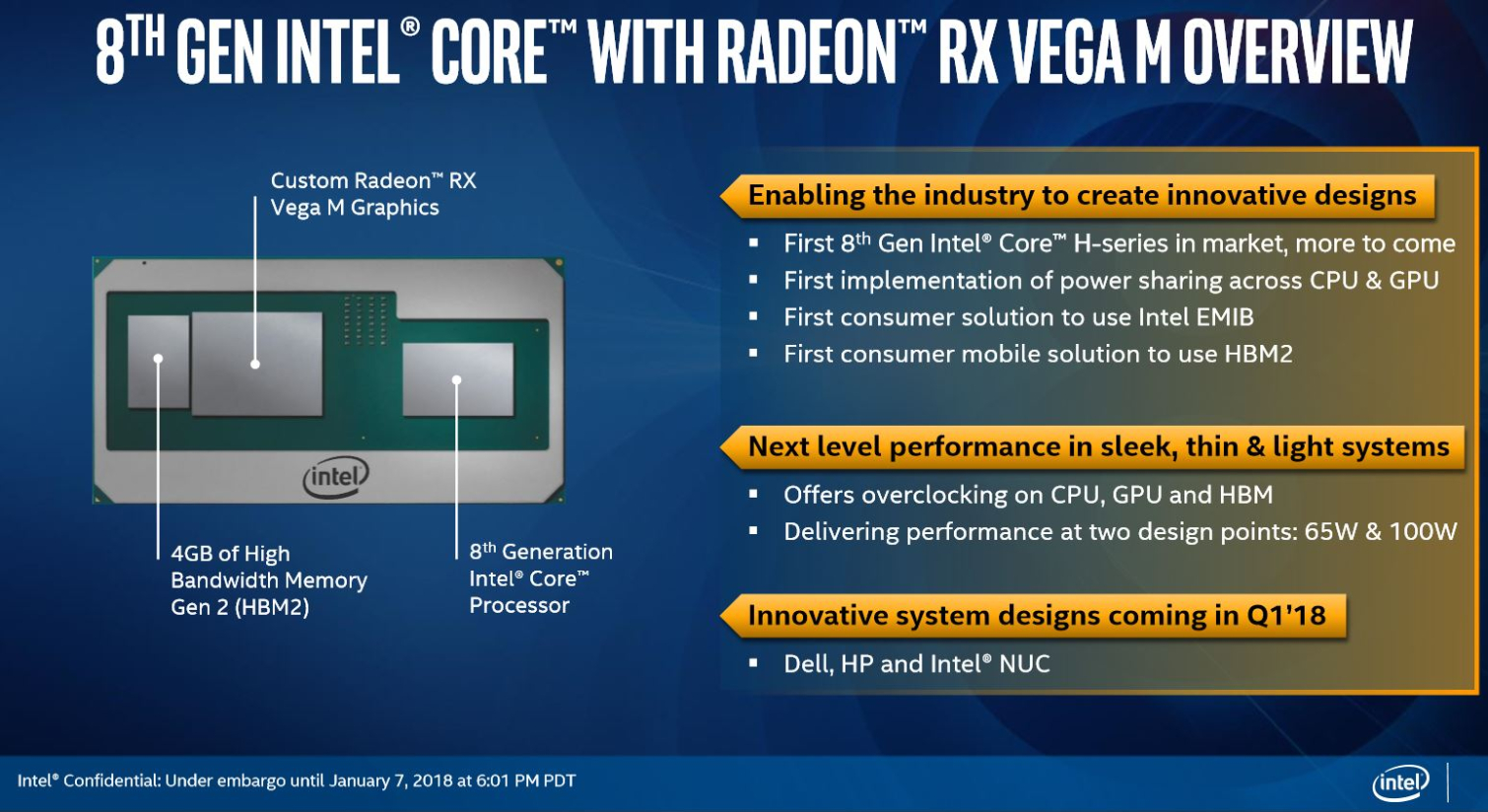


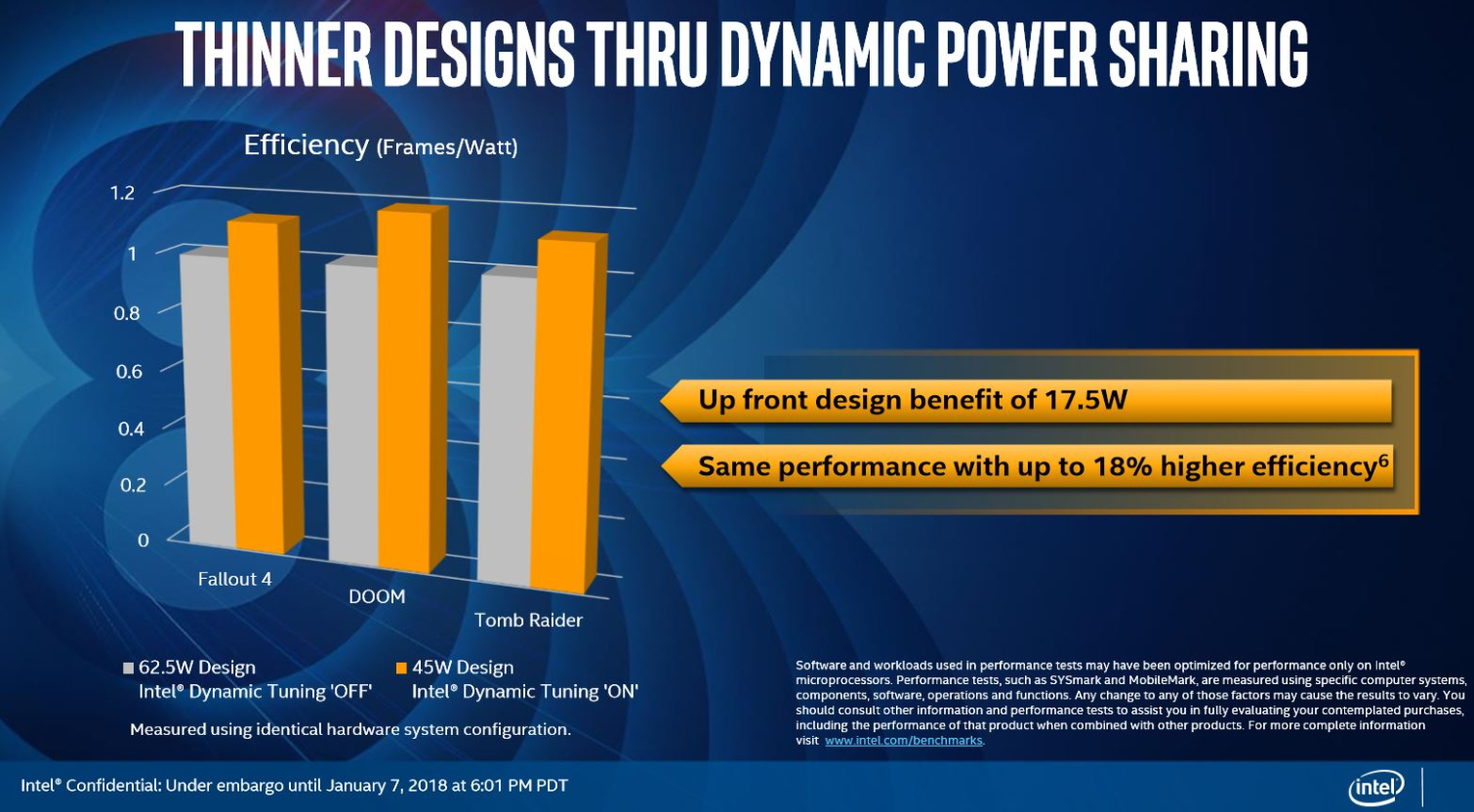
Reducing the amount of power a device consumes helps mitigate thermal generation. Intel's Vega implementation has similarities to AMD's Ryzen Mobile, which was the first CPU with integrated graphics to transition from using two power rails. Previous-gen processors featured two power rails, one dedicated to the CPU and another dedicated to the GPU. Both the Intel Vega processors and Ryzen Mobile use a single rail for both regions to enable power sharing. That allows the SoC to dedicate more current to regions that are experiencing heavier load, which boosts performance. It also saves power. The power-sharing technology also includes the HBM2 stack. A unique set of software drivers and interfaces process telemetry data from the three units (CPU, GPU, HBM2) so the processor can manage heat, power delivery, and performance in real time.
Thoughts
It's easy to forget that Intel is the leading supplier of PC graphics, but that's due to the number of processors that sell with integrated graphics. Intel's decision to use AMD's Radeon Graphics is a strategic move that likely serves several purposes. First, Intel cannot currently challenge Nvidia's graphics performance leadership in the mobility market. Intel's integrated graphics are capable, but they don't have a reputation for being class leading. AMD's expertise in this area provides instant access to a competitive graphics architecture.
Intel's new Vega-infused processors can seriously threaten Nvidia's market share if they deliver on the performance claims. Nvidia's discrete graphics solutions are much thicker than this new solution, and it's going to be hard to compete with 17mm gaming laptops with a 27mm device. Intel's design could make significant headway in a short period of time, if it's competitive. The semi-custom AMD graphics chips also buy Intel some time until its own homegrown discrete GPU initiative, now headed by ex-AMDer Raja Koduri, can deliver a new or updated graphics architecture.
Many also wonder why AMD would sell graphics units to Intel, but the answers could be simple. AMD doesn't have a presence in the discrete mobile GPU market yet, so any revenue from that segment is "extra," and its Ryzen Mobile processors compete in a far lower performance bracket. Intel isn't licensing AMD's graphics technologies; it's purchasing the semi-custom AMD graphics processors as a finished product. If AMD decides to compete in the 65W-100W range, in the future, it would likely follow its tried-and-true tactic of offering competitive performance for a lower price point. For now, Intel serves as a good customer that creates positive cash flow. Moreover, you could argue that anything that hurts Nvidia is good for AMD.
If Intel gets pricing right and delivers these products to market promptly, it could have a winner on its hands. It's easy to imagine that most OEMs will be very interested, especially as the design matures.
Intel told us that we can expect system designs in spring 2018. Meantime, Intel released information on its new line of NUCs, and Dell and HP also have NUCs coming soon, but the details remain under wraps.

Paul Alcorn is the Editor-in-Chief for Tom's Hardware US. He also writes news and reviews on CPUs, storage, and enterprise hardware.
-
Lucky_SLS How long will this hades nuc last if it's just dota and other mundane tasks? Have to see if it's worth it over an upgradable matx platform.Reply -
FunAndGames "which tipped us off that the new overclockable processors would , as we suspected."Reply
from this articel. "would , as we suspected." ??? -
FunAndGames 1st paragraph, last sentence...quoteReply
"The new processors will even make their way into the ."
???
WTF? The new processors will even make their way into the period?
2nd paragraph, 1st sentence...quote
"We first learned of Intel's plans in November 2017 when the company disclosed that it was developing a new ."
WTF? so Intel is developing a new period? -
FunAndGames 2nd paragraph, 2nd sentence...quoteReply
"Surprisingly, that means Intel is now an AMD customer. Early this week, Intel accidentally posted one of the new processors to its India site, which tipped us off that the new overclockable processors would , as we suspected."
WTF? these overclockable processors would comma as we suspected? -
Paul Alcorn Reply20571060 said:2nd paragraph, 2nd sentence...quote
"Surprisingly, that means Intel is now an AMD customer. Early this week, Intel accidentally posted one of the new processors to its India site, which tipped us off that the new overclockable processors would , as we suspected."
WTF? these overclockable processors would comma as we suspected?
Hello, thank you for commenting. The missing text is in fact there, but they are hyperlinked words. I see the words in three different browsers, so perhaps you have an ad blocker or virus protection that is scrubbing links? if you still cannot see the text I can report it to management. -
alextheblue You know, if someone had asked me six months ago who would be the first to integrate HBM (HBC?) on-package with an APU... my answer would not have been Intel. Strange world.Reply
I'm also a little surprised Vega was able to go toe to toe (even if only on certain titles) with a 1060, with only 24 CUs and a single stack of HBM2.
-
Paul Alcorn Reply20571163 said:You know, if someone had asked me six months ago who would be the first to integrate HBM (HBC?) on-package with an APU... my answer would not have been Intel. Strange world.
I'm also a little surprised Vega was able to go toe to toe (even if only on certain titles) with a 1060, with only 24 CUs and a single stack of HBM2.
You're telling me :pt1cable: -
-Fran- Word on the street (tm) is that Intel had a saying in how that Vega GPU came to be. That explains why they're able to compete with nVidia using a respectable TDP.Reply
Cheers! -
Dosflores There's a typo in the fourth paragraph: "According to Intel, now it can beat an Nvidia 1080 Max-Q in gaming". I guess you meant 1060.Reply



